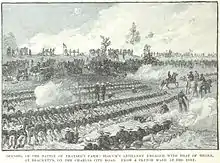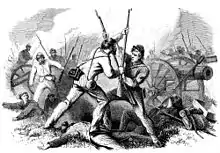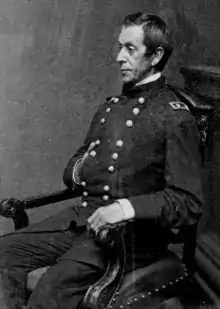Battle of Glendale
The Battle of Glendale, also known as the Battle of Frayser's Farm, Frazier's Farm, Nelson's Farm, Charles City Crossroads, New Market Road, or Riddell's Shop, took place on June 30, 1862, in Henrico County, Virginia, on the sixth day of the Seven Days Battles (Peninsula Campaign) of the American Civil War.[6]
| Battle of Glendale | |||||||
|---|---|---|---|---|---|---|---|
| Part of the American Civil War | |||||||
 Monday's fight. The battle of Charles City road. Alfred R. Waud, artist, June 30, 1862 | |||||||
| |||||||
| Belligerents | |||||||
|
|
| ||||||
| Commanders and leaders | |||||||
| George B. McClellan[2] | Robert E. Lee | ||||||
| Units involved | |||||||
| Army of the Potomac | Army of Northern Virginia | ||||||
| Strength | |||||||
| 40,000[3] | 45,000[4] | ||||||
| Casualties and losses | |||||||
|
3,797 total (297 killed 1,696 wounded 1,804 missing or captured)[5] |
3,673 total (638 killed 2,814 wounded 221 missing)[5] | ||||||
The Confederate divisions of Maj. Gens. Benjamin Huger, James Longstreet, and A.P. Hill converged on the retreating Union Army in the vicinity of Glendale or Frayser's Farm. Longstreet's and Hill's attacks penetrated the Union defense near Willis Church. Union counterattacks sealed the break and saved their line of retreat along the Willis Church Road. Huger's advance was stopped on the Charles City Road. The divisions led by Maj. Gen. Thomas J. "Stonewall" Jackson were delayed by Brig. Gen. William B. Franklin's corps at White Oak Swamp. Confederate Maj. Gen. Theophilus H. Holmes made a feeble attempt to attack the Union left flank at Turkey Bridge but was driven back. This had been Lee's best chance to cut off the Union army from the James River. That night, the Union army established a strong position on Malvern Hill.[7]
Background
Military situation
The Seven Days Battles began with a Union attack in the minor Battle of Oak Grove on June 25, 1862, but McClellan quickly lost the initiative as Lee began a series of attacks at Beaver Dam Creek (Mechanicsville) on June 26, Gaines's Mill on June 27, the minor actions at Garnett's and Golding's Farm on June 27 and June 28, and the attack on the Union rear guard at Savage's Station on June 29. McClellan's Army of the Potomac continued its retreat toward the safety of Harrison's Landing on the James River.[8]
After Gaines's Mill, McClellan left his army with no clear instructions on routes of withdrawal and without naming a second-in-command. The bulk of the V Corps (less McCall), under Brig. Gen. Fitz John Porter, moved to occupy Malvern Hill, while the remaining four corps of the Army of the Potomac were essentially operating independently in their fighting withdrawal. Most elements of the army had been able to cross White Oak Swamp Creek by noon on June 30. About one third of the army had reached the James River, but the remainder was still marching between White Oak Swamp and Glendale. (Glendale was the name of a tiny community at the intersection of the Charles City Road and the Quaker Road, or Willis Church Road, which led over Malvern Hill to the James River.)[9] After inspecting the line of march that morning, McClellan rode south and boarded the ironclad USS Galena on the James.[10]
Lee ordered his Army of Northern Virginia to converge on the retreating Union forces, bottlenecked on the inadequate road network. The Army of the Potomac, lacking overall command coherence, presented a discontinuous, ragged defensive line. Stonewall Jackson was ordered to press the Union rear guard at the White Oak Swamp crossing while the largest part of Lee's army, some 45,000 men, would attack the Army of the Potomac in mid-retreat at Glendale, about 2 miles (3.2 km) southwest, splitting it in two. Huger's division would strike first after a three-mile (5 km) march on the Charles City Road, supported by Longstreet and A.P. Hill, whose divisions were about 7 miles (11 km) to the west, in a mass attack. Holmes was ordered to cannonade retreating Federals near Malvern Hill.[11]
Opposing forces
Union
| Key Union Commanders |
|---|
|
Confederate
Battle

As with most of the Seven Days Battles, Lee's plan was poorly executed. Huger was slowed by felled trees obstructing the Charles City Road, a result of the efforts of pioneers from Brig. Gen. Henry W. Slocum's division. Huger had his men spend hours chopping a new road through the thick woods in what became known as the "Battle of the Axes". He failed to take any alternative route, and, fearing a counterattack, failed to participate in the battle. By 4 p.m., Lee ordered Maj. Gen. John B. Magruder to join Holmes on the River Road and attack Malvern Hill, the left flank of the Union line, then ordered him to assist Longstreet, so his division spent the day countermarching. Stonewall Jackson moved slowly and spent the entire day north of the creek, making only feeble efforts to cross and attack Franklin's VI Corps in the Battle of White Oak Swamp, attempting to force back the enemy by a fruitless artillery duel so that a destroyed bridge could be rebuilt, even though adequate fords were nearby. (Despite his stunning victories in the recent Valley Campaign, or possibly due to the fatigue of that campaign, Jackson's contributions to the Seven Days were marred by slow execution and poor judgment throughout.) Jackson's presence did cause two of Brig. Gen. John Sedgwick's three brigades, which had been defending the Charles City crossroads, to move north as reinforcements. McCall's division had stopped at Charles City Crossroads on its march to rejoin Porter. The gap in the line by Sedgwick was noticed and plugged by his three brigades. Holmes's inexperienced troops (from his Department of North Carolina, attached to the Army of Northern Virginia) made no progress against Porter at Turkey Bridge and Malvern Hill and were repulsed by artillery fire and by the Federal gunboats Galena and Aroostook on the James.[12]

At 2 p.m., as they waited for sounds of Huger's expected attack, Lee, Longstreet, and visiting Confederate President Jefferson Davis were conferring on horseback when they came under heavy artillery fire, wounding two men and killing three horses. A.P. Hill, commanding in that sector, ordered the president and senior generals to the rear. Longstreet attempted to silence the six batteries of Federal guns firing in his direction, but long-range artillery fire proved to be inadequate. He ordered Col. Micah Jenkins to charge the batteries, which brought on a general fight around 4 p.m.[13]
Although belated and not initiated as planned, the assaults by the divisions of A.P. Hill and Longstreet, under Longstreet's overall command, turned out to be the only ones to follow Lee's order to attack the main Union concentration. Longstreet's 20,000 men were not reinforced by the Confederate divisions of Huger and Jackson, despite their concentration within a three-mile 3 miles (4.8 km) radius. They assaulted the disjointed Union line of 40,000 men, arranged in a 2 miles (3.2 km) arc north and south of the Glendale intersection, but the brunt of the fighting centered on the position held by the Pennsylvania Reserves division of the V Corps, 6,000 men under Brig. Gen. George A. McCall, just west of the Nelson farm, north of Willis Church. (The farm was now owned by R.H. Nelson, but many locals still called it Frayser's or Frazier's Farm.)[14] McCall's division included the brigades of Brig. Gen. George G. Meade on the right and Brig. Gen. Truman Seymour on the left, with the brigade of Brig. Gen. John F. Reynolds (led by Col. Seneca G. Simmons since Reynolds's capture at Boatswain's Swamp after Gaines's Mill) in reserve.[15]

Three Confederate brigades were sent forward in the assault, from north to south: Brig. Gen. Cadmus M. Wilcox, Col. Micah Jenkins (Anderson's Brigade), and Brig. Gen. James L. Kemper. Longstreet ordered them forward in a piecemeal fashion, over several hours. Kemper's Virginians charged through the thick woods first and emerged in front of five batteries of McCall's artillery. In their first combat experience, the brigade conducted a disorderly but enthusiastic assault, which carried them through the guns and broke through McCall's main line with Jenkins's support, followed up a few hours later by Wilcox's brigade of Alabamians. The Confederate brigades met stiff resistance from Meade and Seymour in bitter hand-to-hand combat where men stabbed each other with bayonets and used rifles as clubs. Officers even took to using their (normally ornamental) swords as weapons. Meade was wounded in the fighting, two of his artillery batteries captured (Lt. Alanson Randol's and Capt. James Cooper's), but one was retaken. Col. Simmons, commanding Reynolds's brigade, was killed and McCall was captured when he mistakenly rode into the Confederate picket line, looking for positions to place his rallied men. Brig. Gen Truman Seymour assumed command of the division. Generals Sumner and Heintzelman were both hit by stray bullets in the fighting; the former suffered no serious injury, but the latter was unable to use his right hand for a few weeks. Cpt. George Hazzard, commanding Battery A of the 4th US Artillery, was also mortally wounded.[16]
On McCall's northern flank, the division of Brig. Gen. Philip Kearny held against repeated Confederate attacks with reinforcements of Caldwell's brigade and two brigades from Slocum's division. On the southern flank, Brig. Gen. Joseph Hooker's division repelled and once pursued minor attacks. Sedgwick's division, whose brigades had returned from near White Oak Swamp, came up to fill a gap after a brutal counterattack. Heavy fighting continued until about 8:30 p.m. Longstreet committed virtually every brigade in the divisions under his command, while on the Union side they had been fed in individually to plug holes in the line as they occurred.[17]
Aftermath
The battle was tactically inconclusive, although Lee failed to achieve his objective of preventing the Federal escape and crippling McClellan's army, if not destroying it. Longstreet's performance had been poor, sending in brigade after brigade in a piecemeal fashion, rather than striking with concentrated force in the manner for which he would be known later in the war. He also was not supported by Huger and Jackson, as Lee had planned. Instead of attacking, both generals merely kept their divisions on the north side of White Oak Swamp and launching no action other than an occasional artillery exchange. Union casualties were 3,797 (297 killed, 1,696 wounded, and 1,804 missing or captured). Confederate casualties were comparable in total—3,673 (638 killed, 2,814 wounded, and 221 missing)—but more than 40% higher in killed and wounded. Longstreet lost more than a quarter of his division.[18] Union generals Meade, Heintzelman, Edwin V. Sumner and Confederate generals Joseph R. Anderson, Dorsey Pender, and Winfield S. Featherston were wounded.[5]
On the evening of June 30, McClellan, who had witnessed none of the fighting, wired the War Department: "My Army has behaved superbly and have done all that men could do. If none of us escape we shall at least have done honor to the country. I shall do my best to save the Army." He later requested 50,000 reinforcements (which the War Department had no chance of providing). "With them, I will retrieve our fortunes."[19] McClellan has received significant criticism from historians about his detachment from the battle, sailing on the Galena out of touch while his men fought. Ethan Rafuse wrote that after McClellan supervised the deployment of three corps near the Glendale crossroads, what he did next "almost defies belief. ... Even though his men were at the time engaged in a fierce battle near Glendale ... he spent the afternoon on board the Galena, dining with [Captain] Rodgers and traveling briefly up river to watch the gunboat shelling of a Confederate division that had been spotted marching east along the River road toward Malvern Hill." Brian K. Burton wrote that, "more than on any other day, McClellan's judgment on the thirtieth is suspect. He had arranged for signal communications between Malvern Hill and the river but that is a poor substitute. To leave units from five different corps at a vital point with no overall commander is to court disaster." Stephen W. Sears wrote when McClellan deserted his army on the Glendale and Malvern Hill battlefields during the Seven Days, "he was guilty of dereliction of duty."[20]
After the battle, Lee wrote, "Could the other commands have cooperated in this action, the result would have proved most disastrous to the enemy."[21] Confederate Maj. Gen. D.H. Hill was even more direct: "Had all our troops been at Frayser's Farm, there would have been no Malvern Hill."[22] Confederate Brig. Gen. Edward Porter Alexander wrote after the war that, "Never, before or after, did the fates put such a prize within our reach. It is my individual belief that on two occasions in the four years, we were within reach of military successes so great that we might have hoped to end the war with our independence. ... The first was at Bull Run [in] July 1861 ... This [second] chance of June 30, 1862 impresses me as the best of all."[23]
Lee would have only one more opportunity to intercept McClellan's army before it reached the safety of the river and the end of the Seven Days, at the Battle of Malvern Hill on July 1.[24]
Part of the battle took place on Gravel Hill, a community established for slaves freed by Quaker Robert Pleasants before 1800. Although what had been once the historic Gravel Hill School had been destroyed, it was replaced by Gravel Hill Baptist Church in 1866, and the community remains close-knit today.[25]
Battlefield preservation
The Civil War Trust (a division of the American Battlefield Trust) and its partners have acquired and preserved 719 acres (2.91 km2) of the battlefield in more than 15 separate acquisitions since 1995.[26]
See also
Notes
- (Union withdrawal continued)
- Rafuse, p. 227; Sears, Gates of Richmond, pp. 280–81; Burton, pp. 241–42. Army of the Potomac commander McClellan was not present during the battle and named no second-in-command. The highest-ranking corps commander present was Maj. Gen. Edwin V. Sumner. Sears, Young Napoleon, p. 219, quotes Samuel P. Heintzelman as saying that McClellan's generals fought their troops "entirely according to their own ideas."
- Kennedy, p. 100.
- Salmon, p. 113.
- Eicher, p. 293.
- The NPS battle summary Archived February 21, 2006, at the Wayback Machine lists the alternative names for the battle, although most other sources do not mention Riddell's Shop. Riddell's blacksmith shop was located at the Glendale crossroads (Sears, Gates of Richmond, p. 278) and was an alternative name for the Glendale Cross Roads (Welcher, p. 825). Another engagement took place in this area on June 13, 1864, during the Overland Campaign, and the name Riddell's Shop is usually used for that.
- NPS Archived February 21, 2006, at the Wayback Machine.
- Salmon, p. 64.
- Burton, p. 165.
- Eicher, pp. 290–91; Kennedy, p. 98; Salmon, p. 113.
- Eicher, p. 291; Salmon, pp. 113–15; Burton, pp. 268–69; Sears, Gates of Richmond, p. 291.
- Burton, pp. 257–58, 273–75; Kennedy, p. 100; Salmon, p. 115; Eicher, pp. 291–92.
- Burton, p. 275; Sears, Gates of Richmond, p. 290; Kennedy, p. 100.
- Sears, Gates of Richmond, p. 294.
- Kennedy, p. 100; Salmon, p. 116.
- Burton, pp. 289, 295–96; Sears, Gates of Richmond, pp. 294–99; Kennedy, p. 100; Salmon, p. 116.
- Sears, Gates of Richmond, pp. 300–306; Burton, pp. 282–86; Kennedy, p. 100; Salmon, p. 116.
- Sears, Gates of Richmond, p. 307.
- Wert, pp. 116–17.
- Rafuse, p. 227; Burton, p. 243; Sears, Controversies and Commanders, p. 17.
- Lee's battle report, Official Records, Series I, Vol XI/2 [S# 13].
- Alexander, p. 98.
- Alexander, pp. 109–110.
- Salmon, p. 66.
- http://www.styleweekly.com/richmond/the-descendants/Content?oid=1724271
- American Battlefield Trust "Saved Land" webpage. Accessed May 25, 2018.
References
- Alexander, Edward P. Fighting for the Confederacy: The Personal Recollections of General Edward Porter Alexander. Edited by Gary W. Gallagher. Chapel Hill: University of North Carolina Press, 1989. ISBN 0-8078-4722-4.
- Burton, Brian K. Extraordinary Circumstances: The Seven Days Battles. Bloomington: Indiana University Press, 2001. ISBN 0-253-33963-4.
- Eicher, David J. The Longest Night: A Military History of the Civil War. New York: Simon & Schuster, 2001. ISBN 0-684-84944-5.
- Esposito, Vincent J. West Point Atlas of American Wars. New York: Frederick A. Praeger, 1959. OCLC 5890637.
- Kennedy, Frances H., ed. The Civil War Battlefield Guide. 2nd ed. Boston: Houghton Mifflin Co., 1998. ISBN 0-395-74012-6.
- Rafuse, Ethan S. McClellan's War: The Failure of Moderation in the Struggle for the Union. Bloomington: Indiana University Press, 2005. ISBN 0-253-34532-4.
- Salmon, John S. The Official Virginia Civil War Battlefield Guide. Mechanicsburg, PA: Stackpole Books, 2001. ISBN 0-8117-2868-4.
- Sears, Stephen W. Controversies & Commanders: Dispatches from the Army of the Potomac. Boston: Houghton Mifflin Co., 1999. ISBN 0-395-86760-6.
- Sears, Stephen W. George B. McClellan: The Young Napoleon. New York: Da Capo Press, 1988. ISBN 0-306-80913-3.
- Sears, Stephen W. To the Gates of Richmond: The Peninsula Campaign. New York: Ticknor and Fields, 1992. ISBN 0-89919-790-6.
- U.S. War Department, The War of the Rebellion: a Compilation of the Official Records of the Union and Confederate Armies. Washington, DC: U.S. Government Printing Office, 1880–1901.
- Welcher, Frank J. The Union Army, 1861–1865 Organization and Operations. Vol. 1, The Eastern Theater. Bloomington: Indiana University Press, 1989. ISBN 0-253-36453-1.
- Wert, Jeffry D. The Sword of Lincoln: The Army of the Potomac. New York: Simon & Schuster, 2005. ISBN 0-7432-2506-6.
- National Park Service battle description
- CWSAC Report Update
Further reading
- Crenshaw, Douglas. The Battle of Glendale: Robert E. Lee's Lost Opportunity. Charleston, SC: The History Press, 2017. ISBN 978-1-62619-892-0.
External links
- Battle of Glendale: Maps, histories, photos, and preservation news (Civil War Trust)
- Battle of Glendale in Encyclopedia Virginia
- Animated history of the Peninsula Campaign


